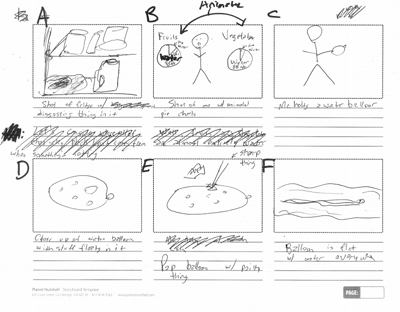Link to Nathan Hernandez's Page on Tumblr
Contents
Day 1 Pitch
> Download from iTunes U (MP4 - 14.1MB)
> Download from Internet Archive (MP4 - 14.1MB)
This video is courtesy of WaywardLightning on YouTube and is provided under our Creative Commons license.
Lots lots lots lots to improve
Just a few things:
- I say "you know" so much it hurts
- Narrow down subject matter (decrease breadth (5 minutes is too long) and increase depth)
- Basically, I need to script it instead of following an outline (which we will do)
- Visuals
- Better things to do with my body
Day 2 Script: Draft for "How does Food Turn to Mush?"
Me opening fridge, going 'ugh' and camera looks at rotten veggies
Goes to me in some setting…kitchen burred in bg, me in fg???
Have you ever wondered how things rot in the fridge? Like, it's literally a flesh eating disease just chilling in your kitchen.
bottom of screen "don't worry, it can't eat you"
No big deal. Ask anyone and they'll be saying something along the lines of "it's bacteria I think." And that's mostly true but how does it work?!?! How does it turn a perfectly good floret of broccoli
Screen to picture of perfectly healthy broccoli
Into that?
Screen to picture of disgusting broccoli decay mush. Shudder.
After this I won't be doing instructions for visuals since there's waaaaay too many to figure out at this time
Well, the wide and wonderful world is full of a variety of creatures, among them bacteria and fungi, many of these whom—we'll call them Saprophytes—survive entirely by eating dead matter, playing crucial roles in the recycling of carbon and nitrogen back into the living world. Instead of how we eat food and digest it in our stomachs, these organisms break down their food outside their bodies and then absorb the small food particles in a process known as extracellular digestion.
How food is broken down is largely dependent on what type of food it is. Fresh foods, like fruit and veggies and meat rot a whole lot differently than processed foods like potato chips do. In this video, we're going to focus on fresh foods and in particular, veggies and fruits.
When looking at vegetables and fruits, determining whether fungus or bacteria can infect it is largely dependent on pH, or how acidic something is. Fungus tends to function in all pHs while bacteria prefer more neutral zones. Vegetables are susceptible to both, because they often have a nearly perfectly neutral pH. Fruit, on the other hand, are more acidic, and mostly only have fungi to worry about.
Let's look at broccoli. Since broccoli is a vegetable, it has to deal with fungi and bacteria.
When a bacteria or fungus wants to invade the broccoli, it'll secrete an enzyme to break down the outer barriers of the broccoli's cells, which is made of cellulose and other polysaccharides, or complex sugars. Once it's past this barrier, the water and other nutrients of the cell are released. This is what causes that gross liquid to form around the plant.
After this, the invader will release a variety of enzymes. Amylases will break down storage starches into simple sugar. Lipases will break apart any lipids into fatty acids and glycerol. Proteases will break the bonds between proteins and result in amino acids.
As smaller particles form, the fungi and bacteria will absorb the nutrients through passive diffusion, transport, and endocytosis.
Usually this process takes 10–14 days to reach a point at which it probably isn't safe to eat the veggie / fruit and after it'll start to look like this.
How do you prevent your fresh food from going bad? My advice, eat your veggies.
Day 3 Pitch
> Download from iTunes U (MP4 - 4.9MB)
> Download from Internet Archive (MP4 - 4.9MB)
This video is courtesy of WaywardLightning on YouTube and is provided under our Creative Commons license.
Very rough
Day 4 Storyboard

Script for the Scene
- Let's consider where all of that icky black liquid comes from when something's rotting.
- Well, fruits and vegetables are almost entirely water,
- so on the most basic level, you could say a plant cell is an extremely complex water balloon.
- The elastic outside is the cell wall and membrane and the water inside is the intracellular fluid. When a bacteria or fungi uses enzymes to break down the exterior of a cell,
- it's like if I were to pop the balloon.
- The water and nutrients that come out are what cause the muck you see in your fridge.
Rough Cut: Breaking Down Decomposition
> Download from iTunes U (MP4 - 8MB)
> Download from Internet Archive (MP4 - 8MB)
This video is courtesy of WaywardLightning on YouTube and is provided under our Creative Commons license.
I will explain why it's so terrible.
Final Project: Breaking Down Decomposition
> Download from iTunes U (MP4 - 8MB)
> Download from Internet Archive (MP4 - 8MB)
This video is courtesy of WaywardLightning on YouTube and is provided under our Creative Commons license.
Creative Commons: CC BY-NC-SA, MIT
Hosted By: Nathan Hernandez
Written By: Nathan Hernandez
Additional Scripting: Elizabeth Choe, George Zaidan, Andrea Desrosiers
Executive Producer: Nathan Hernandez
Director: Nathan Hernandez
Editor: Nathan Hernandez
Production Assistant: Andrea Desrosiers
See the full credits on the course Tumblr.
